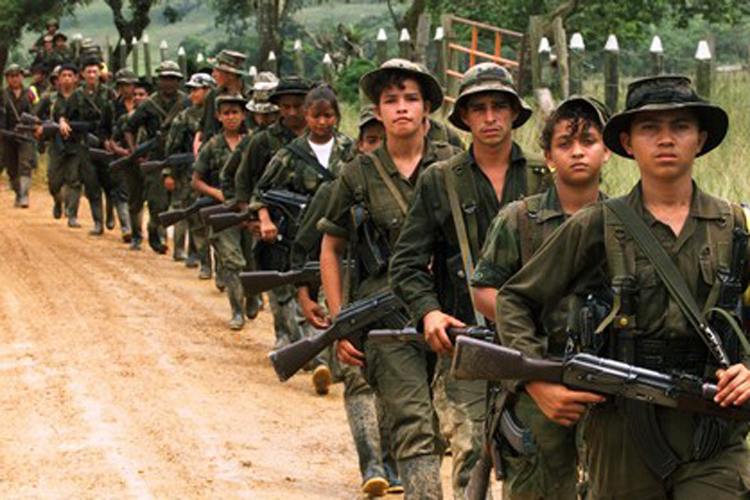Photo Credit: therepublicsquare.com
First in a series by Marcelle Cohen (LBJ MGPS Student) covering her internship at La Allianza Iniciativa de Mujeres Colombianas por la Paz.
I came to Colombia in late May, inspired by the peace process that a hopeful international press had promised would finally put an end to the world’s longest civil war. The peace talks taking place in Havana between the Colombian government, lead by President Juan Manuel Santos, and the leftist guerrilla Revolutionary Armed Forces of Colombia (the FARC), have been lauded as exemplary for their focus on victims and securing important gains such as demining, ending child recruitment, and applying a strong gender focus. Inside Colombia, however, activists report that the path to peace is littered with chasms.
The Colombian conflict, now over 50 years long, has left over 220,000 dead (80% of which were civilians), and over 5 million displaced. In its wake is left a fragile democracy corrupted by criminal politicians and impunity, ruptured social trust, and an untold number raped, brutalized, vulnerable, demoralized, and embittered. And not only that: after generations of conflict, violence has been battered into institutions built on hard power and naturalized into the national psyche.
“Conflict is in our culture,” Diana González, an activist at La Alianza Iniciativa de Mujeres Colombianas por la Paz (Alianza IMP), a women’s peace organization, told me. “Did you really think that it could all change when some men signed a little piece of paper?”
Although the peace talks in Havana have experienced robust advances and have benefited from widespread international support, the negotiations process and the peace process are not one and the same. Peace itself goes beyond political agreements and diplomacy, and must be built into the social fabric, and even into individual psychology of its citizens to be deemed legitimate.
During a conference on achieving Colombia’s peace, Rosa Emilia Salamanca – Executive Director of CIASE, a women’s collective for peace – explained that the moral extremes of the conflict had left Colombians dehumanizing the enemy to the point of monstrosity. During the conflict, bloodshed had been celebrated, breaking the limits of respect for fellow Colombian women and men.
“We are a very wounded society,” Salamanca said. “To achieve peace, Colombia must unlearn all the hatred that war taught us….and we must move beyond our paradigm of winning the war and try to win peace.”
This task of winning peace is made all the more complex by the fact that the dialogues in Havana are taking place in the middle of the conflict. The peace accords stipulate a unilateral cease-fire for the FARC, which has been continuously broken in retaliation for government attacks, resulting in a deteriorating humanitarian crisis and an indignant citizenship. The Colombian people won’t be able to believe in the logic of a peace process that is taking place while the conflict continues and even escalates. The continuing conflict stifles public will for peace and holding peace talks during a conflict has caused dialogues to drown in past processes. A bilateral cease-fire is needed for the talks to gain legitimacy and move forward.
Luis Sandoval, author and leader of the National Council for Peace, explained to me that the complexity in achieving peace internally is further compounded by the fact that President Santos’ administration is communicating with the FARC, but not with Colombian society. Colombia’s deep inequality is a widely-cited cause of the conflict, and the most affected by the violence have always been the country’s most vulnerable. Misogyny and prejudice, in the context of war, have come armed with guns. No one has suffered more from the conflict as a group than women, followed by Afro-Colombians, and Indigenous groups, mostly living in rural Colombia. Sandoval said that with the process, these populations need to know that the country is surpassing it’s democratic deficit, that participation is expanding. This is only achieved through inclusion and a government’s active communication with its citizenship—and especially with the conflict’s victims.
So in light of the divorce between the peace process occurring in the tables of Havana and the one occurring in Colombian territories and society, we must ask ourselves how peace will be measured in Colombia. In the tidy black-inked pages of the policy documents constructed by government officials? In the forked tongues and bloodied hands of FARC leaders and military presidents? The cold and dust-laden metal of unused arms stockpiles?
Or will peace dwell in the forgiveness of a victim that was savaged by conflict? The reconciled memories of children born into violence? Democracy stretching out its rigid arms to embrace Colombia’s excluded?
The definition of peace needs to be expanded beyond its traditional meaning of a cease-fire between opposing parties in order to be sustainable. Both the complexity and solution to a resonating peace in Colombia are found in it’s society—Colombia’s peace cannot be circumscribed to the accords in Havana. For Colombian peace to go beyond arms reduction, the Colombian people need to be protagonists in their country’s transformation, extending democracy and participation to Colombia’s forgotten sectors and territories.
For President Santos’ administration, this means reflecting on what society thinks of the accords. Will society validate them or not? What does a society marred by the world’s longest civil war need in order to heal?
Edited by Jon Brandt

